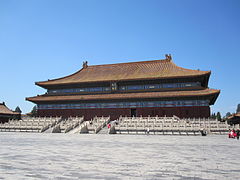Imperial Ancestral Temple
The Imperial Ancestral Temple, also called Taimiao, was a place for ceremonies honoring the ancestors of the imperial family during the Ming and Qing dynasties in Beijing, China. It was located in the Imperial City near the Forbidden City.[1] It is a Jongmyo
| Imperial Ancestral Temple | |
|---|---|
太廟 | |
 The Hall for Worship of Ancestors | |
 | |
| General information | |
| Location | Imperial City |
| Estimated completion | 1420 (18th year of Yongle Emperor) |
The temple was made up of several buildings in three large courtyards separated by walls. The most important building was the Hall for Worship of Ancestors, which was one of the four buildings in Beijing that stood on a three-tiered platform, showing its great importance. In this hall, there were seats and beds for the tablets of emperors and empresses, as well as incense burners and offerings. The emperor would come here to participate in large ceremonies honoring the ancestors.[1]
There were also two long, narrow buildings on the sides of the Hall for Worship of Ancestors. One building was for worshiping meritorious courtiers, while the other was for various princes of the Ming or Qing dynasty. Behind the Hall for Worship of Ancestors, there were two other main halls, one of which was built in 1420 and used to store imperial spirit tablets.
By the 1920s, the Imperial Ancestral Temple became a public park called the Working People's Cultural Palace. Today, the park has expanded from its original size and is located east of Tiananmen Square. This park, along with several other parks like Zhongshan Park, Beihai Park, and Jingshan Park, have a deep connection to the Forbidden City.